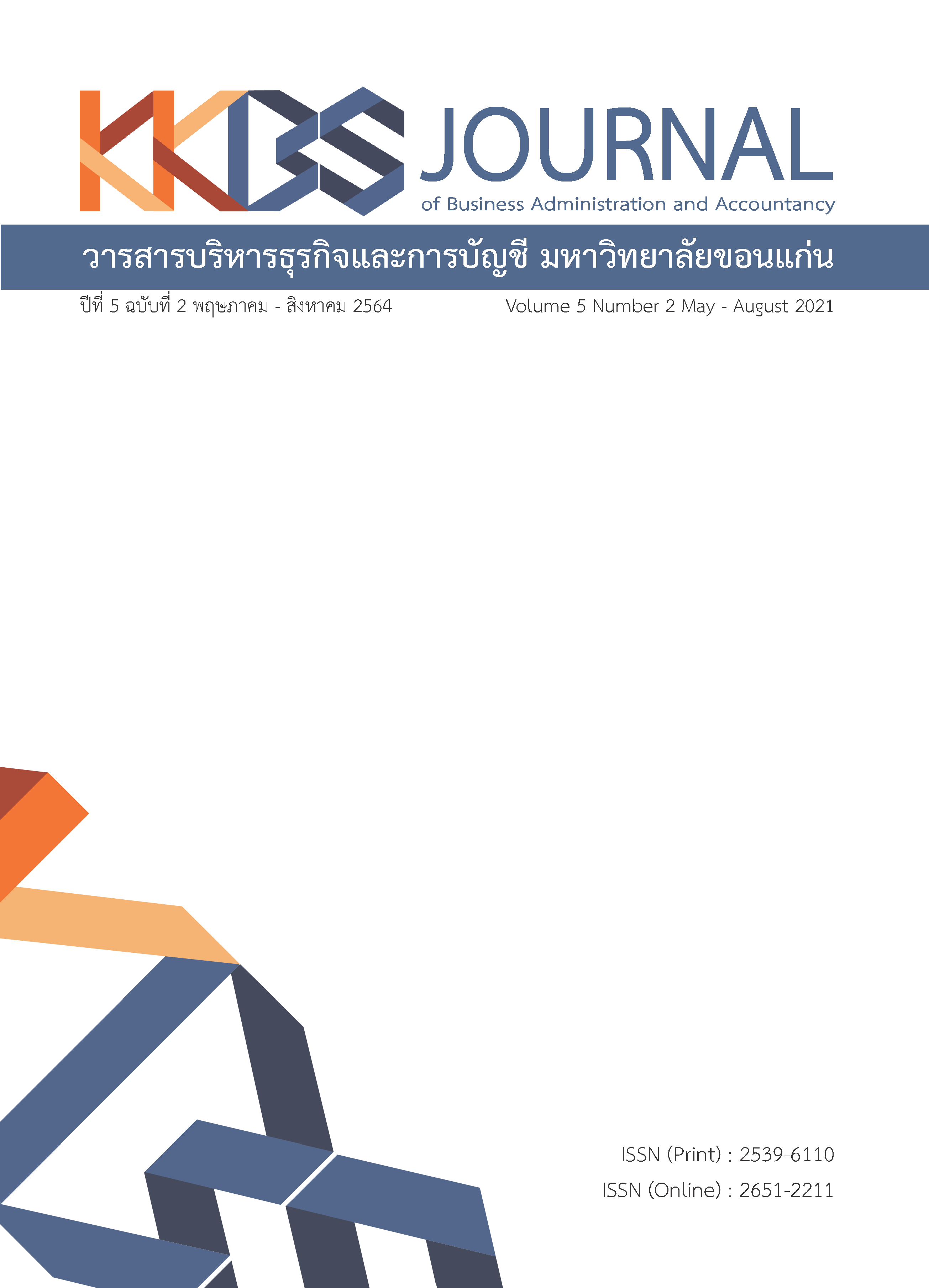ความสอดคล้องระหว่างแนวคิดเกี่ยวกับตัวเองกับความหลงใหลในตราสินค้าที่ตอบสนองความตั้งใจซื้อ: สินค้าประเภทที่ใช้ในพื้นที่สาธารณะ (รถยนต์)
Main Article Content
บทคัดย่อ
งานวิจัยนี้มีศึกษาเกี่ยวกับความสอดคล้องระหว่างแนวคิดเกี่ยวกับตนเองกับความหลงใหลในตราสินค้าที่มีผลต่อการตั้งใจซื้อสินค้าประเภทที่ใช้ในพื้นที่สาธารณะ (Publicly Consumed Product) : (รถยนต์)งานวิจัยนี้เป็นงานวิจัยเชิงปริมาณ ผู้วิจัยใช้แบบสอบถามผ่านสื่อสังคมออนไลน์ (Google Form) เป็นเครื่องมือในการรวบรวมข้อมูลและกลุ่มตัวอย่างที่ศึกษาในครั้งนี้คือ ประชากรในประเทศไทยที่มีอายุตั้งแต่ 21- 45 ปี จำนวน 400 คน และวิเคราะห์ข้อมูลโดยใช้การวิเคราะห์โมเดลสมการโครงสร้างแบบ SEM (Structural Equation Modeling: SEM) โดยตัวแปรที่ใช้ในการวิจัยครั้งนี้ประกอบด้วยตัวแปรความสอดคล้องในตนเอง (Self-Congruence) ซึ่งแบ่งออกเป็น 2 มิติ คือ 1)ความสอดคล้องในตนเองที่แท้จริง (Actual-Self Congruence) และ 2)ความสอดคล้องในตนเองในอุดมคติ (Ideal-Self Congruence) ความหลงใหลในตราสินค้า (Brand Passion) และความตั้งใจซื้อ (Purchase Intention) จากการวิจัยพบว่า (ASCC) ความสอดคล้องในตนเองที่แท้จริงมีอิทธิพลเชิงบวกต่อ (BPPP) ความหลงใหลในตราสินค้า ตรงกันข้ามกับ (ISCC) ความสอดคล้องในตนเองในอุดมคติที่ไม่มีอิทธิพลต่อ (BPPP) ความหลงใหลในตราสินค้า และ (PCII) ความตั้งใจซื้อมีอิทธิพลเชิงบวกต่อ (BPPP) ความหลงใหลในตราสินค้า
Article Details
บทความที่ได้รับการตีพิมพ์ในวารสารเป็นความคิดเห็นของผู้เขียน มิใช่ความคิดเห็นของกองบรรณาธิการและคณะผู้จัดทำวารสาร และบทความที่ได้รับการตีพิมพ์เป็นลิขสิทธิ์ของวารสารบริหารธุรกิจและการบัญชี มหาวิทยาลัยขอนแก่น
References
Aaker, D.A. (1991). Managing brand equity. New York: Free Press.
Ahuvia, A.C. (2005). Beyond the extended self: loved objects and consumers' identity narratives. The Journal of Consumer Research, 32(1), 171–85.
Ajzen, I. (1991). The theory of planned behavior. Organizational Behavior and Human Decision Processes, 50(2), 179–211.
Albert, N., Merunka, D. & Valette-Florence, P. (2008). The feeling of love toward a brand: Concept and measurement. Advances in Consumer Research, 36, 300–7.
Albert, N., Merunka, D. & Valette-Florence, P. (2013). Brand passion: Antecedents and consequences. Journal of Business Research, 66(7), 904–909.
Assael, H. (2004). Consumer behavior: A strategic approach. Boston: Houghton Mifflin.
Astakhova, M., Swimberghe, K.R. & Wooldridge, B.R. (2017). Actual and ideal-self congruence and dual brand passion. Journal of Consumer Marketing, 34(7), 664–672.
Baumeister, R.F. & Bratslavsky, E. (1999). Passion, intimacy and time: passionate love as a function of change in intimacy. Personality and Social Psychology Review, 3(1), 47–67.
Bauer, H., Heinrich, D. & Martin, I. (2007). How to create high emotional consumer-brand relationships? The causalities of brand passion. Sydney: Australian & New Zealand Marketing Academy.
Berkman, H.W., Lindquist, J.D. & Sirgy, J.M. (1997). Consumer behavior. Chicago: NCT Business Book.
Coyle, J.R. & Esther, T. (2001). The effects of progressive levels of interactivity and vividness in web marketing sites. Journal of Advertising Research, 30, 65-77.
Chon, K. & Olsen, M.D. (1991). Functional and symbolic congruity approaches to consumer satisfaction/dissatisfaction in consumerism. Journal of the International Academy of Hospital Research, 3(4), 1-18.
Das, G. (2014). Linkages of retailer personality, perceived quality and purchase intention with retailer loyalty: A study of Indian non-food retailing. Journal of Retailing and Consumer Services, 21(3), 407-414.
Dolich, I.J. (1969). Congruence relationship between self-image and product brands. Journal of Marketing Research, 6(1), 80-84.
D’lima, C. (2018). Brand passion and its implication on consumer behavior. International Journal of Business Forecasting and Marketing Intelligence, 4(1), 30-42.
Dumaine, B. (1991). Design that sells and sells and…. Fortune, 123(5), 56-61.
Engel, J.F., Blackwell, R.D. & Miniard, P.W. (1995). Consumer behavior. 6th ed. Chicago: Dryden Press.
Govers, P.C.M. & Schoormans, J.P.L. (2005). Product personality and its influence on consumer preference. Journal of Consumer Marketing, 22(4), 189-197.
Hatfield, E. & Walster, W.G. (1978). A new look at love. Lantham: University Press of America.
Hatfield, E. (1988). Passionate and companionate love. In R.J. Sternberg & M.L. Barnes (Eds.) The psychology of love (pp. 191–217). New Heaven: Yale University Press.
Hawkins, D.I., Best, R.J. & Coney, K.A. (2004). Consumer behavior: Building marketing strategy. 9th ed. New York: McGraw-Hill.
Hong J.W. & Zinkhan, G.M. (1995). Self-concept and advertising effectiveness: The influence of congruence, conspicuousness, and response mode. Psychology & Marketing, 12(1), 53-77.
Hosany, S. & Martin, D. (2011). Self-image congruence in consumer behavior. Journal of Business Research, 65(5), 1-7.
Holzwarth, M., Janiszewski, C. & Neumann, M.M. (2006). The influence of avatars on online consumer shopping behavior. Journal of Marketing, 70(4), 19–36.
Keh, H.T, Pang, J. & Peng, S. (2007). Understanding and measuring brand love. Santa Monica: Society for Consumer Psychology.
Khan, B.M. (2010). Brand personality and consumer congruity: Implications for advertising strategy. The IUP Journal of Brand Management, 7(1), 7-24.
Kotler, P. (2003). Marketing management. 11th ed. Upper Saddle River, NJ.: Prentice-Hall.
Kotler, P. & Keller K.L. (2016). Marketing management. 15th ed. Edinburgh: Pearson Education.
Malär, L. et al. (2011). Emotional brand attachment and brand personality: The relative importance of the actual self and the ideal self. Journal of Marketing, 75, 35-52.
Mukherjee, K. (2019). Social media marketing and customers’ passion for brands. Marketing Intelligence and Planning, 38(4), 509-522.
Palmatier, R.W. et al. (2006). Factors influencing the effectiveness of relationship marketing: A meta-analysis. Journal of Marketing, 70(4), 136-153.
Parker, B.T. (2009). A comparison of brand personality and brand user-imagery congruence. Journal of Consumer Marketing, 26(3), 175-184.
Phillippe, F.L., Vallerand, R.J. & Lavigne, G.L. (2009). Passion does make a difference in people's lives: A look at well-being in passionate and non-passionate individuals. Applied Psychology: Health and Well-Being, 1(1), 3–22.
Sirgy, M.J. (1982). Self-concept in consumer behavior: a critical review. The Journal of Consumer Research, 9(3), 287–300.
Sirgy, M.J. (1985). Using self-congruity and ideal congruity to predict purchase motivation. Journal of Business Research, 13(3), 195-206.
Sirgy, M.J. et al. (1997). Assessing the predictive validity of two methods of measuring self-image congruence. Journal of the Academy of Marketing Science, 25(3), 229-241.
Sirgy, M.J., Grewal, D. & Mangleburg, T. (2000). Retail environment, self-congruity, and retail patronage: An integrative model and a research agenda. Journal of Business Research, 49(2), 127-138.
Solomon, M.R. (2011). Consumer behavior. 9th ed. Upper Saddle River, N.J.: Prentice Hall.
Todd, S. (2001). Self-concept: A tourism application. Journal of Consumer Behavior, 1(2), 184-196.
Thomson, M. MacInnis, D.J. & Park, C.W. (2005). The ties that bind: Measuring the strength of consumers’ emotional attachments to brands. Journal of Consumer Psychology, 15(1), 77–91
Vallerand, R.J et al. (2003). Les passions de l'âme: On obsessive and harmonious passion. Journal of Personality and Social Psychology, 85(4), 756–767.
Veryzer, R.W. (1995). Product design, aesthetics, and consumer research" in F.R. Kardes & M.Sujan, Eds. Advances in consumer research volume 22. Pravo, UT.: Association for Consumer Research.
Zeithaml, V.A., Parasuraman, A. & Berry, L.L. (1990). Delivering quality service: Balancing customer perceptions and expectations. New York: The Free.

